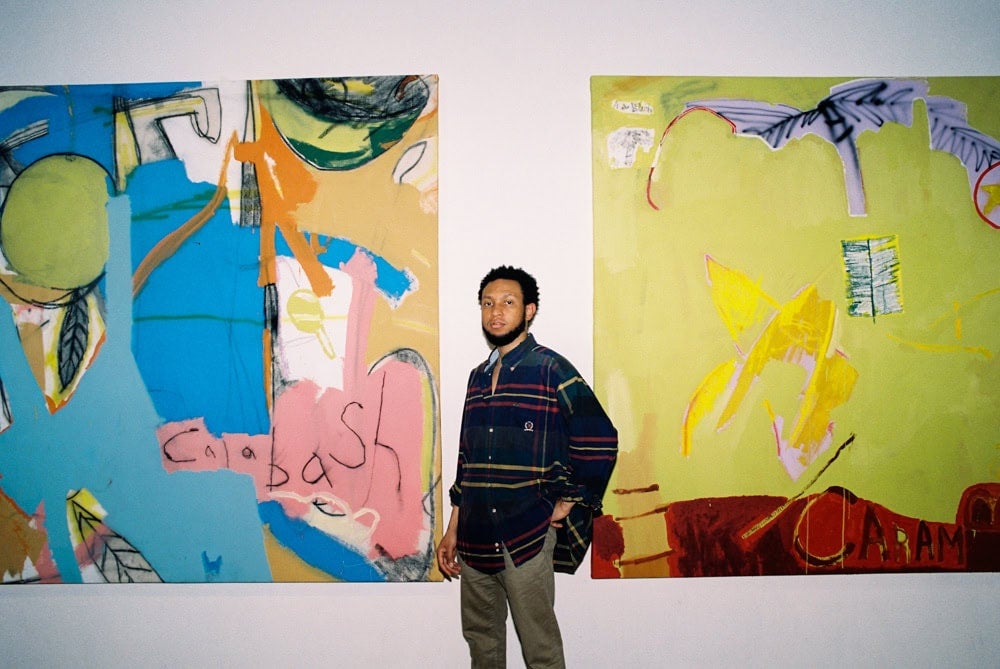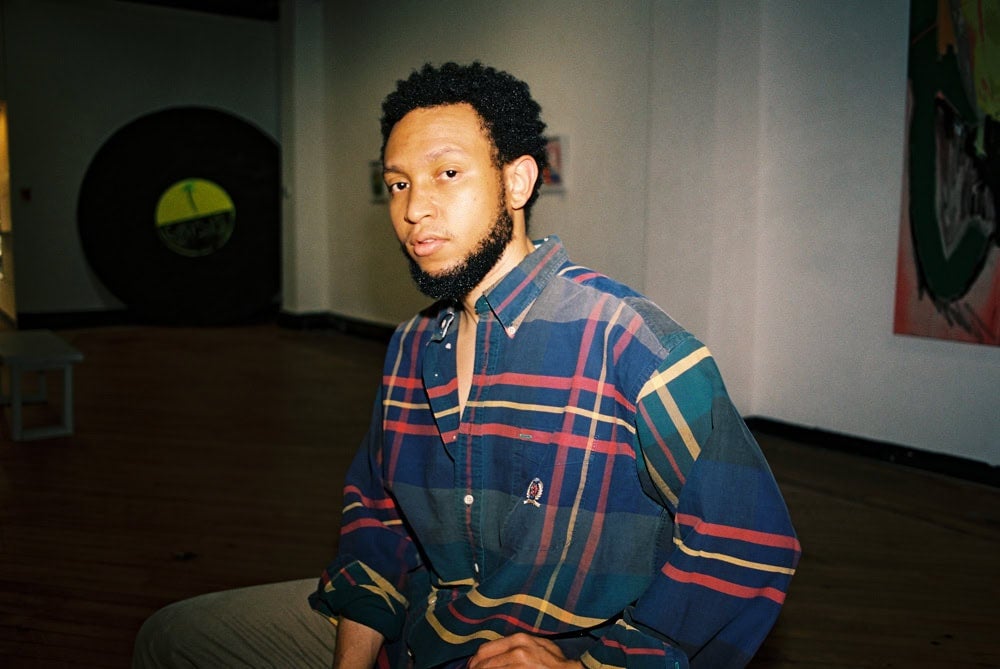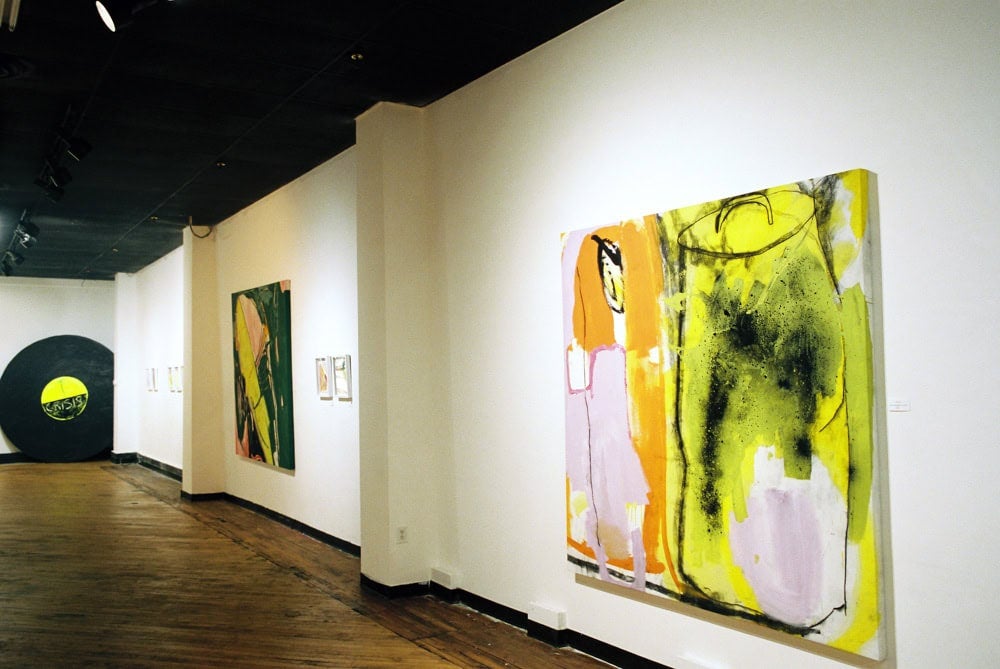
Artist Hasani Sahlehe relocated to the Savannah, Georgia, from St. Thomas, Virgin Islands, to pursue a degree in painting at the Savannah College of Art and Design, graduating in 2015. In 2018, Sahlehe presented exhibitions in Sliver Space at Atlanta Contemporary, at the SCAD Museum of Art in Savannah, and was selected as a MINT Leap Year Fellow. Fruit of the Spirit, his solo exhibition presented as part of that program, remains on view at MINT in Atlanta through Saturday, March 16.
For this conversation, 2019/2020 Leap Year Fellow Caleb Jamel Brown spoke with Sahlehe in the gallery at MINT.
Caleb Jamel Brown: In this exhibition and in your recent exhibition Banana Republic at the SCAD Museum, fruit has been a common subject in your work. Why fruit?
Hasani Sahlehe: When it comes to depicting fruits or plant life, or even dishes that are not derived from the earth—you know, I’ve depicted things like barbecue chicken, stewed chicken, jerk chicken, stuff like that—it goes back to something that David Sturgis, the chef at the Goat Farm, once said: “The history of food is the real history of the world.” I had been painting fruits, specifically tropical fruits from where I come from—St. Thomas, Virgin Islands—for a while. Working as an artist, you trust your feelings—you may be curious about it, but you just follow your instincts and trust that answers will come alive at some point. Hearing that statement really summed up a lot of what I was making.
CJB: So you’re using the imagery of fruit and food to explore different histories and cultures, or your own history and culture?
HS: I’m definitely using my own culture as a stepping stone, but it doesn’t only apply to my culture or community. I’m thinking about the role that food plays as an aspect of cultural output, similar to music, dance, painting—there’s food. I was thinking about how dishes become a cultural mainstay in a particular region, how certain food becomes traditional or ceremonial. For instance, my show at Atlanta Contemporary was called What a Kallaloo—so kallaloo is a traditional dish where I come from, and when I was growing up, I remember it being eaten around New Year’s time. I hated the smell of it. (Laughs)
CJB: Is it a celebratory thing?
HS: In some ways, it’s supposed to bring you good tidings in the New Year. We would freeze the ham bone from Thanksgiving, traditionally, and put it in the kallaloo to make this leaf-based stew in the New Year’s time. This became a staple where I came from—for my grandparents, and my great-grandparents, that’s who I grew up with—it became an important tradition. So how did that happen? Did the recipe spontaneously appear on every grandmother’s table?
CJB: Being from Atlanta, or the Southern United States, there’s a similar tradition of eating collard greens with a ham bone, so it’s a similar leafy stew.
HS: I actually just learned that from Malik [Jalal]; he mentioned it at my artist talk.
CJB: That has to transcend each of our home countries—our cultural Blackness still plays a part.

HS: So you’re from the South?
CJB: Yeah, from Atlanta.
HS: Well, I’m from even further south, in the Caribbean. So I learned that the kallaloo was derived from a West African dish, and that’s just one example of how a tradition can be passed down over regions, over tragic situations, conflict, all these different things, and still derive meaning. Even though it’s not the same in a new generation, at its core, it serves the same purpose: bringing good tidings.
CJB: In this case, since it’s derived from a West African dish, it appeared on this side of the world involuntarily, due to the capturing and shipping of our ancestors.
HS: Right. I wanted to focus on the way it manifested in this new place, under these new circumstances. So in order for that to happen, there’s been a bit of assimilation to this place, but also spontaneity and improvisation, and working with what you have to make to make new traditions. So the work also speaks to the way that traditions constantly overlap—they shift, they blend, and they become new things.
Banana Republic, at the SCAD Museum, was a bit more of a celebration of the forces that brought these new hybrid cultures to exist. This show kind of explores hybrid cultures as well, but it’s not meant to be a celebration. There are some aspects of it that are celebratory, but it’s more of an exploration of what happens afterwards, and it questions the cultural influences that brought us from the past to the present.

CJB: I also wanted to ask about the imagery of the palm trees—or are they banana trees? Is that a reference to home?
HS: Both of those trees have become part of my visual language. The palm tree speaks to the idea of home, the idea of how I relate to this representation of paradise or going on a vacation.
CJB: Well, there’s a certain contradiction there…
HS: Exactly. I grew up in a place where many people vacation, and that’s a reality. But my experience growing up there is not going to be the same as someone staying there for a week. I’ve experienced what it’s like to grow up in a place where tourism is our economy, that’s our main export. Our culture, our natural resources—the sun, the beach—these are our exports.
And the palm tree has another layer of significance for me: it’s a symbol of home, but I’ve learned recently that some species of palm trees aren’t native to the Caribbean, they come from other places around the world. So this just speaks again to how we can consistently adapt new things to identify as culture or traditions, and how cultures and traditions are really fluid. In our mind we can decide, “This is the time stamp. This is home. This song is always going to represent this summer.”
Hasani Sahlehe‘s MINT Leap Year exhibition Fruit of the Spirit is on view at MINT in Atlanta through March 16.




